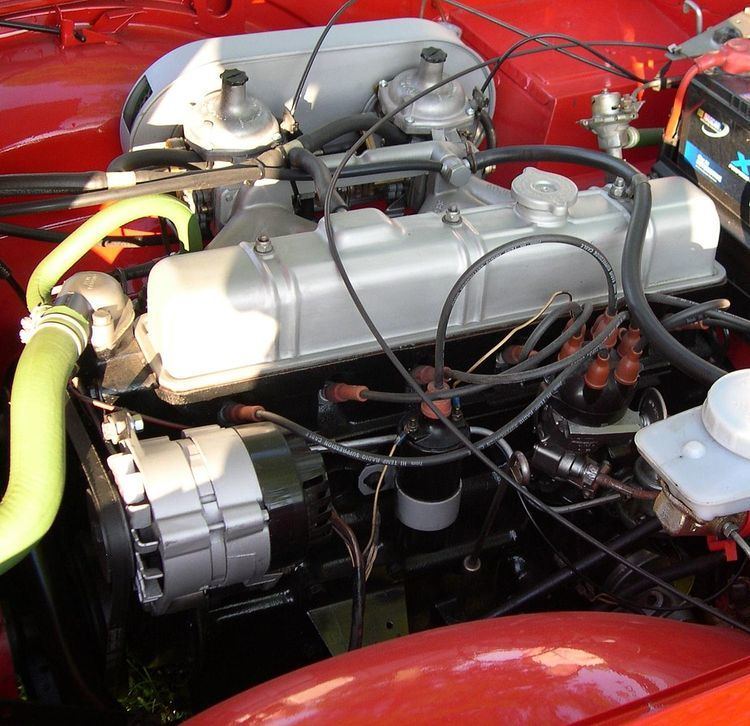Also called Triumph Six Cylinder Successor Leyland PE166 engine | Production 1960–1977 | |
 | ||
Manufacturer Standard Triumph
Leyland Motors
British Leyland
TVR | ||
The Triumph Six Cylinder or Triumph I6 engine is a straight-six engine made from cast-iron and using pushrod-actuated overhead valves. The engine was introduced by Standard Triumph in their Standard Vanguard Six in 1960. It has been used in several vehicles, including some kit cars.
Contents
Standard Eight engine
The Triumph six is based on the 4 cylinder engine first used in the Standard Eight in 1953. Displacement of the engine in the Eight was 803 cc.
The engine was modified a number of times for use in the Standard Ten, Triumph Herald, and Triumph Spitfire. First for the 948 cc Herald, and again for the 1147 cc Herald 1200, the cylinders were re-aligned to give better clearance for the head studs and allow the bore to be enlarged. The engine was further developed and bored from 69.3 mm (2.7 in) in the 1147 cc version to 73.7 mm (2.9 in) giving 1296 cc for the Herald 13/60, the stroke was also increased from 76 mm (3.0 in) to 86.5 mm (3.4 in) providing 1493 cc for the Spitfire 1500.
Two cylinders added
The six cylinder engine was developed from the four used in the Eight and the Ten. It was first used in 1960 in the Standard Vanguard Six, in which it had a 74.6 mm (2.9 in) bore and a 76 mm (3.0 in) stroke, giving a capacity of 1998 cc.
The engine was next used in the Triumph Vitesse, a sports saloon based on the Herald, in 1962. In this application, the engine had a 66.75 mm (2.6 in) bore, reducing displacement to 1596 cc. The Vitesse was given the two-litre engine with the 74.6 mm bore in 1966.
The Triumph 2000 replaced the Vanguard Six in 1963 when Leyland discontinued the Standard marque. The two-litre six was later used in the Spitfire-based GT6 coupé from 1966 to 1974.
Beginning in 1967, the engine was used in the Triumph TR5 and TR250 sportscars, replacing the Standard inline-four engine used in TRs from the TR2 to the TR4A. For this application, the stroke was increased to 95 mm (3.7 in), giving 2498 cc. This new 2.5-litre version gave 150 bhp (112 kW; 152 PS) at 5500 rpm in the TR5 when equipped with the Lucas mechanical fuel injection system. The TR250 was sold in the US with Stromberg carburettors to avoid the need for additional emissions control systems; this reduced the power to 105 bhp (78 kW; 106 PS) at 4500 rpm. The TR6, made from 1969 to 1975, used a 106 hp version of the TR250's engine in the United States and the TR5's engine elsewhere, although the fuel injected engine was detuned to 125 bhp (93 kW; 127 PS) in 1973.
The fuel-injected 2 1⁄2-litre engine became available in the 2000 unit body as the 2.5 PI in 1968; this was supplanted by the twin-carburettor 2500 TC in 1974. The 2000 and 2500 TC were discontinued in 1977.
Technical
A partial chart of Triumph engine numbers is posted on the "Spitfire & GT6 magazine" site. However the capacity appears not to match the bore/stroke, or that published on other sites including the GT6 Ezine, hence the corrections in the tables below.
Engine Applications Chart
Factory Quoted Power Chart
Racing
Triumph raced Spitfires, and some early GT6 prototypes at Le Mans, with some good success, and later at Sebring but due to rule changes and the takeover by Leyland, this was not continued.
Replacement
After Triumph, and later Rover, were absorbed into Leyland Motors in 1960, and 1967 respectively, work began on a successor to both the Triumph 2000 and the Rover P6 which would also use a new straight six engine design. The engine, known internally as the Leyland PE166 was originally intended to be a development of the Triumph I6, but ended up becoming an entirely new design, with almost no interchangeable parts with the original. The Rover SD1 was the only recipient of this engine in both 2.3L and 2.6L capacities.
